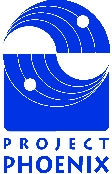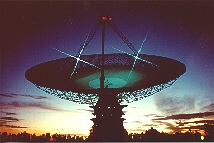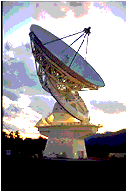


Project Phoenix, operated by the SETI Institute, is the world's most sensitive and comprehensive search for extraterrestrial intelligence. Its aim is to detect the presence of other civilisations by listening for radio signals that are either being deliberately beamed our way, or are inadvertently transmitted from another planet. It is the sucessor to the ambitious NASA SETI programme which was cancelled by the American Congress in 1993.

The Parkes Telescope in Australia.
Phoenix is using a targeted search stratagy so, rather than scanning the whole sky, monitors the positions of nearby, sun-like stars. It is on planets in orbit around similar long lived, but relativly bright, stars such as our Sun that it is expected that other life forms would be most likely expected to evolve. Around 1000 stars within a distance of 200 light-years have been selected for observation by Project Phoenix.
We obviously do not know at what frequency any extraterrestrial signals might be being transmitted, but there is a wide band of frequencies between 1,000 and 10,000 MHz where the background noise, for example from our Galaxy, is a minimum. Mobile phones operate at the lower end of this band and Satellite Television at the other. The most common element in the Universe, Hydrogen emits at a frequency of 1420 Mhz whilst Hydrogen bonded to a single Oxygen atom to form the radical OH radiates at frequencies near 1600 Mhz. This defines a smaller band which, as H and OH together form water, is known as the "Water Hole". Perhaps this would be chosen by others wishing to communicate with us.
To scan such a broad band in the same way as one tunes across the band of an FM radio would be a very slow proces. This is particulary so as we would expect that very narrowband signals, like morse code, would be used. Such signals are much easier to detect over long distances than more complex transmissions such as TV signals. Thus a receiver with millions of channels operating simultaneously is used to step across the band and up to two billion channels are examined for each star.
This is beyond the capability of any human and so the "listening" is done by computer. The computer system automatically eliminates known sources of local interference either from the ground or from the increasing number of satellites in orbit around the earth. Should any signal pass this scrutiny, a procedure is automatically initiated to either confirm or exclude the signal as having an extraterrestrial origin.
Two further receiver systems are called into use, one at the prime telescope, for example Parks, and the second at the secondary telescope, in this case Mopra. They both specifically search for the signal that has been detected which, because of the rotation of the Earth, will have different characteristics at the two sites. Observations at both sites are thus able to exclude any signals originating near the Earth, and the second telescope can provide an immediate confirmation that the signal is of extra terrestrial origin.

The 140ft radio telescope at Green Bank, West Virginia.

|
Return to the NRAL / Jodrell Bank Home page |